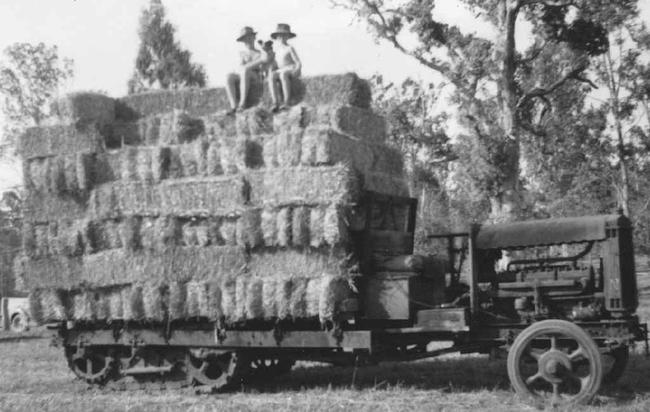Scott family sets history in stone
WHEN John and Eric Scott decided to make a permanent tribute to their late mother and father, they knew that they had to make it big.

Ipswich
Don't miss out on the headlines from Ipswich. Followed categories will be added to My News.
WHEN John and Eric Scott decided to make a permanent tribute to their late mother and father, they knew that they had to make it big.
Alf Scott, who passed away in 1985, would have turned 100 on August 28 last year, and his sons wanted to leave some sign of the family's presence in the rapidly growing Ripley area.
To do so, they picked out an enormous, two-and-a-half metre high, 16-tonne chunk of rock from the family's property, to which they would attach an enormous plaque honouring not only Alf and their mum Lorna, but the Scott family's 122-year attachment to Ripley.
Finding the rock and attaching the plaque seemed easy enough, but how were they ever going to move it from down near the Bundamba Creek, to the little spot they'd picked out high on the hill?
"This was Eric's idea in the beginning," John said.
"We started discussing it about a year ago and basically decided it would be a good idea to do something to mark the history of our family in this area.
"We wanted something that you wouldn't be able to move in a hurry."
If the big hunk of rock looks familiar to some readers, it's probably because they played on or around it during visits to the farm over the years.
Scott's farm has played host to countless sporting club break ups, Scouts and Girl Guide meetings dating back to the 1920s.
The story of how the Scott brothers attempted to move the huge stone centres on a very special and historical piece of machinery - a monstrous thing that has been in the family since the late 1950s.

The 1928 Linn tractor was one of four used by Hancock's sawmill to drag logs to the sawmill at Mt Mistake, south-west of Ipswich, from the 1930s and through the war years.
Equipped with low-revving, 13-litre, six cylinder engines, they were ideal for pulling huge loads of logs through rough terrain.
The machine itself weighed about 7.5 tonnes but could carry loads up to 15 tonne.
"My father worked for Hancocks, doing the maintenance on the steam engines and boilers," John said.
"Just after the war, he tells us, they stopped using the Linns and brought in the big Caterpillar machines."
The Linn tractors were abandoned and left lingering around the Mt Mistake area for years afterward - apart from one particular machine.
The monster that ended up on Scott's farm just happened to be sitting in a garage in North Ipswich after the war.
For some reason, Hancocks had started stripping and rebuilding one of their old Linns before the replacement machines were introduced.
The engine on this one had been done up, but after the Cats were brought in it was as useless as scrap metal, and the sawmill's owners had planned to dump it.
That was until Alf Scott took it off their hands, in 1958.
"It was in one hell of a mess when dad got it," John said.
"A fire had been through it and everything, but my father knew that there were still old parts sitting up on the hill at Mt Mistake.
"He used to pick me up after school and we'd work on the Linn."
With its enormous engine, bulldozer tracks at the rear and hard rubber wheels at the front, the Linn isn't exactly a quiet-running machine.
The sound of it clunking down
the street would bring people out of their houses to see if Armageddon was coming - but it was all part of the charm.
While the Scotts loved using the Linn for its intended purpose - like pulling out stumps around the farm or carting huge loads of hay - it was also a favourite at vintage vehicle rallies in Brisbane and Ipswich.
Older Ipswich residents might recall the old Linn coming to a standstill in the middle of the former Ipswich Colour City Carnival one year - a broken track the culprit.
In the 1960s, the Linn was also used to clear timber off the site of the Swanbank Power Station ash dam - a site which was once part of Scott's farm.
That timber was used to build the houses that John and his brother Eric raised their families in and still live in today.
The machine has a special place in the hearts of the brothers through its link with their parents and the farm, and it was only fitting they should put it to good use when the time came to create the memorial.
With the rock weighing an estimated tonne over the Linn's pulling capacity, it was always going to be a tough ask to get it to drag the thing up a hill.
Photos taken during the mission show Eric Scott performing a wheel stand on the old Linn while trying to shift the rock.
In the end, the Linn couldn't do it alone, and John and Eric linked a few machines from around the farm in a sort of train.
The plaque attached pays homage to six generations of Scott family history, starting from when John and Eric's great-grandfather Henry first took up 40 acres from selection in 1893.
Eric said it was worth the effort.
"Our grandkids are the sixth generation here," he said. "Looking at the way things are going, there might not be much to show people about the history of this place in a few years.
"This might show a bit of what used to go on in the area."


